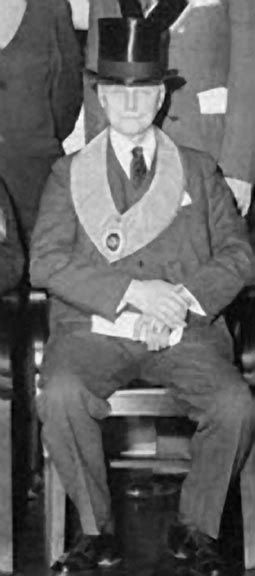
above, a close-up of Crain below. Looks like a doddering old fool here

from the labor relations archives at Cornell
The Prosecuting Attorney
Charles S. Bostwick
The trial was orchestrated by three men. Charles S. Bostwick was the prosecuting attorney. His theory of the case was simple: Locking a factory door during working hours was a misdemeanor, and a misdemeanor that led to a death was felony manslaughter. He set out to prove that Harris and Blanck knowingly ordered an exit door locked on the day of the fire, and that this door prevented the escape of Margaret Schwartz, who died in the blaze. Bostwick wore a brushy moustache and a brooding countenance between his fur-trimmed overcoat and his silk top hat. But his appearance was more dramatic than his performance; the former state assemblyman and professor of corporate law was able, yet colorless, in his conduct of the trial.
For the Defense: Max D. Steuer
Bostwick's opponent was Max D. Steuer, the most celebrated and sought-after attorney in New York during the three decades before his death in 1940. This trial finds Steuer coming into his own, with all the skills that made him famous on display: his photographic memory, his blend of ruthlessness and charm, his devastating cross-examinations. Like many of the Triangle fire victims and witnesses, Steuer was a Jewish immigrant from Eastern Europe; indeed, he worked in a garment sweatshop himself as a boy.
The Controversial Judge
Thomas C.T. Crain is among the most elusive figures in the story of the Triangle fire. Scion of a wealthy New York family, Crain nevertheless owned his career to the mostly working-class political machine known as Tammany Hall. (Steuer was also closely tied to Tammany.) In today's world, Crain probably would not have been allowed to preside, because several years before this trial he, too, had been blamed for a deadly fire. While serving as Tenement House Commissioner in New York City, Crain failed to prevent an apartment house blaze that left 20 people dead. The judge's instructions to the jury at the end of the trial provoked widespread criticism and clearly helped win an acquittal for Harris and Blanck. Still, Crain can also be found in this record taking the prosecution's side in several disputes.
I speculate the case was decided, as they often are, on who is picked to prosecute, defend and judge the case. There was something very sleezy going on at the time in nyc and state politics. There must be some connection between this case and the outcome of the Becker Rosenthal case
See also this article on the tough jews blog

No comments:
Post a Comment